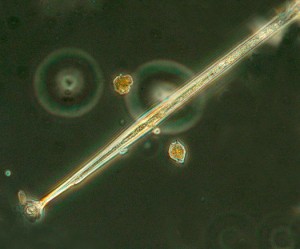It’s not an exaggeration to say Hedrick was ecstatic when she peered into her inverted phase contrast microscope and found Amphisolenia quadrispina floating in her sample. “For 20 years I’ve been hoping to see something like this,” she said. A. quadrispina has a unique long, thin shape that resembles a stick, more than it does other dinoflagellates. It’s huge too — between 600 to 700 microns, which is still smaller than the tip of a needle, but large by phytoplankton standards.
The dinoflagellate came to her in a shipment of samples collected in off India’s South Andaman Islands in the Bay of Bengal. Hedrick has photographed and identified samples from around the world: Asia, the Middle East, Antarctica and North America. She is adding a photo of A. quadrispina to her online Phytoplankton Guide, a source for students and fellow-researchers working with phytoplankton.
You can read more about Hedrick’s work in an article she wrote in a past issue of the Smithsonian Environmental Research Center’s newsletter.
To see the other end of Amphisolenia quadrispina, visit the Phytoplankton Guide.
And last, but not least, check out the Phytoplankton Ecology Lab on the Web.


